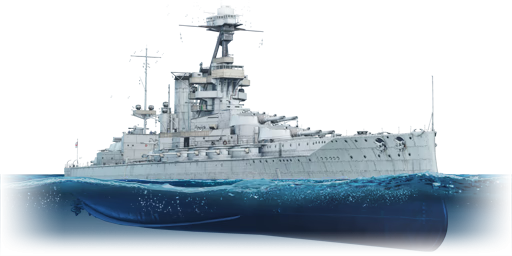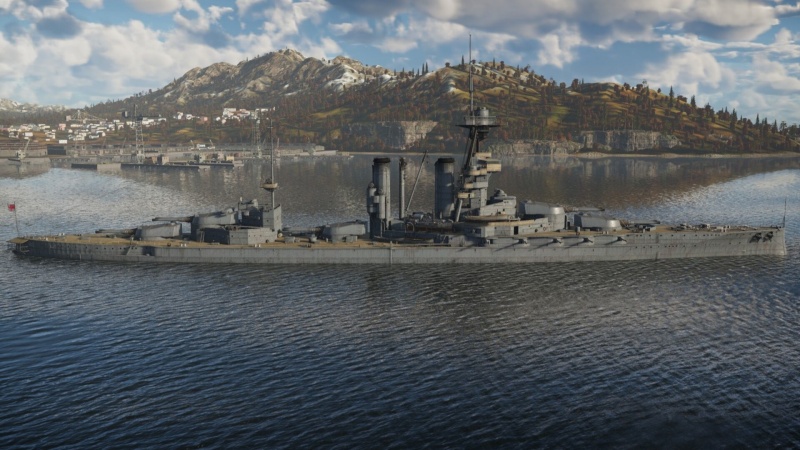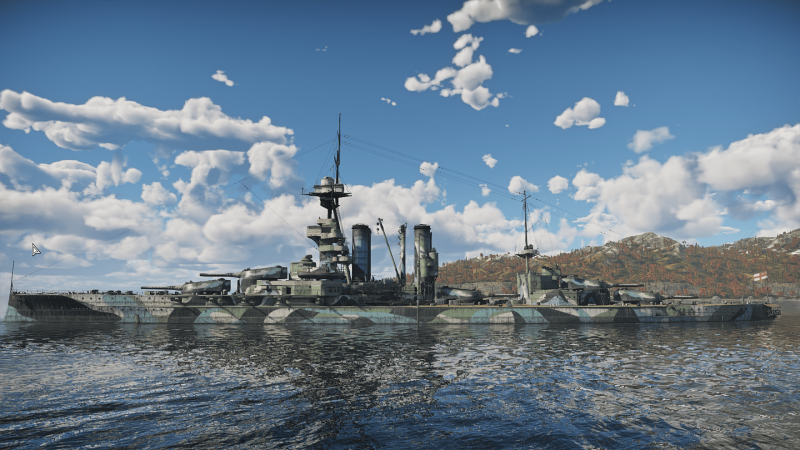HMS Marlborough
Contents
Description
The Iron Duke-class, HMS Marlborough (66), 1927 was the second of four Iron Duke-class battleships, built for the Royal Navy beginning in January 1912. She would be launched later that same year in October of 1912, and would be commissioned in June of 1914, being completed in time for the outbreak of the Great War. The only major action that Marlborough would see would be in the famous Battle of Jutland, where she would engage multiple battleships and cruisers, notably hitting SMS Wiesbaden with (most likely) 3 shells, knocking the cruiser out of action until it sank a few hours later. During this time she had taken a torpedo hit, which while not immediately threatening, would restrict the ship to 12 kn until she was later repaired. She would see more sorties after her repairs were complete, but none would result in combat. After the end of the war, she would serve various roles for an additional 14 years before being stricken and sold for scrap in 1932.
Introduced in Update "Ground Breaking", HMS Marlborough is the most powerful battleship in the British naval line, though not the most powerful ship overall. Though eclipsed by HMS Hood, Marlborough still has a couple advantages, with more guns and a staggering 88.11 kg TNTe explosive mass in the high explosive shells, the most of any ship in-game. This does come at the cost of a lack of anti-aircraft defences as she is in a pre-war refit, along with no torpedo bulges.
General info
Survivability and armour
Talk about the vehicle's armour. Note the most well-defended and most vulnerable zones, e.g. the ammo magazine. Evaluate the composition of components and assemblies responsible for movement and manoeuvrability. Evaluate the survivability of the primary and secondary armaments separately. Don't forget to mention the size of the crew, which plays an important role in fleet mechanics. Save tips on preserving survivability for the "Usage in battles" section. If necessary, use a graphical template to show the most well-protected or most vulnerable points in the armour.
Mobility
Write about the ship's mobility. Evaluate its power and manoeuvrability, rudder rerouting speed, stopping speed at full tilt, with its maximum forward and reverse speed.
| Mobility Characteristics | |||
|---|---|---|---|
| Game Mode | Upgrade Status | Maximum Speed (km/h) | |
| Forward | Reverse | ||
| AB | |||
| Upgraded | 47 | 28 | |
| RB/SB | |||
| Upgraded | 41 | 24 | |
Modifications and economy
Armament
Primary armament
The Marlborough is armed with ten BL 13.5-inch Mark V (H) guns distributed in five twin turrets. Four of these located in the bow and stern, two each, while the fifth turret is located amidships. All are located in the centreline, allowing all main guns to be used in a broadside. They have a maximum rate of fire of 2 rounds/minute with an ace crew. All turrets have +/-150 degrees of traverse, although the amidships turret has somewhat more restricted firing arcs because of the superstructure. Unlike the preceding Dreadnought, the Marlborough has a modern director fire control system that is considerably more accurate and computes firing solutions faster.
The main guns have a choice of four shells: HE, APC Mark Ia, CPC, and APC Mark IIIa. The HE shell has a massive explosive filler of ~88 kg of TNT equivalent. It is capable of inflicting devastating damage against lightly armoured targets such as destroyers and some light cruisers. The APC Mark Ia has a larger explosive filler (~22 kg TNT equivalent) but less penetration, while the later APC Mark IIIa trades a smaller explosive filler (~16.5 kg TNT equivalent) for more penetration. They are most effective against heavier armour, such as on battleships or armoured cruisers. The CPC is a semi-armour piercing round, combining a respectable amount of penetration with a significantly larger explosive filler (~58 kg TNT equivalent) than the APC ammunition. It is most effective against cruisers, but lacks the penetration to get through battleship belt armour.
| Penetration statistics | |||||||
|---|---|---|---|---|---|---|---|
| Ammunition | Type of warhead |
Penetration @ 0° Angle of Attack (mm) | |||||
| 1,000 m | 2,500 m | 5,000 m | 7,500 m | 10,000 m | 15,000 m | ||
| HE | HE | 77 | 77 | 77 | 77 | 77 | 77 |
| APC Mk.Ia | APCBC | 554 | 510 | 447 | 395 | 352 | 294 |
| CPBC | SAPCBC | 300 | 276 | 242 | 214 | 190 | 159 |
| APC Mk.IIIa | APCBC | 591 | 545 | 478 | 422 | 376 | 314 |
| Shell details | ||||||||||||
|---|---|---|---|---|---|---|---|---|---|---|---|---|
| Ammunition | Type of warhead |
Velocity (m/s) |
Projectile mass (kg) |
Fuse delay (s) |
Fuse sensitivity (mm) |
Explosive mass (TNT equivalent) (kg) |
Ricochet | |||||
| 0% | 50% | 100% | ||||||||||
| HE | HE | 759 | 635 | 0 | 0.1 | 88.11 | 79° | 80° | 81° | |||
| APC Mk.Ia | APCBC | 759 | 635 | 0.025 | 20 | 22.22 | 48° | 63° | 71° | |||
| CPBC | SAPCBC | 759 | 635 | 0.035 | 26 | 53.3 | 48° | 63° | 71° | |||
| APC Mk.IIIa | APCBC | 759 | 639.6 | 0.025 | 20 | 14.1 | 48° | 63° | 71° | |||
Secondary armament
The secondary armament of the Marlborough consists of twelve BL 6-inch Mark VII guns located in six casemates on each side of the hull. These have a maximum rate of fire of 7 rounds/minute with an ace crew.
The secondary guns can fire HE or CPC shells. Both shells have fairly large fillers of ~6.6 kg and ~3.7 kg of TNT equivalent, respectively. They are effective against destroyers and can even inflict considerable damage on lightly-armoured cruisers.
| Penetration statistics | |||||||
|---|---|---|---|---|---|---|---|
| Ammunition | Type of warhead |
Penetration @ 0° Angle of Attack (mm) | |||||
| 1,000 m | 2,500 m | 5,000 m | 7,500 m | 10,000 m | 15,000 m | ||
| 6 inch HE | HE | 53 | 53 | 53 | 53 | 53 | 53 |
| 6 inch CPC | SAP | 119 | 102 | 79 | 62 | 50 | 40 |
| Shell details | ||||||||||||
|---|---|---|---|---|---|---|---|---|---|---|---|---|
| Ammunition | Type of warhead |
Velocity (m/s) |
Projectile mass (kg) |
Fuse delay (s) |
Fuse sensitivity (mm) |
Explosive mass (TNT equivalent) (kg) |
Ricochet | |||||
| 0% | 50% | 100% | ||||||||||
| 6 inch HE | HE | 784 | 45.3 | 0 | 0.1 | 6.6 | 79° | 80° | 81° | |||
| 6 inch CPC | SAP | 784 | 45.3 | 0.035 | 7 | 3.4 | 47° | 60° | 65° | |||
Anti-aircraft armament
The anti-aircraft armament of the Marlborough consists of only four QF 4-inch Mark V guns. Two of these are mounted on each side of the bridge conning tower, with another two mounted beneath the aft mast. These do not have a choice of ammunition, firing only HE shells, which severely restricts their effectiveness against aircraft.
Additional armament
The Marlborough has four 21-inch fixed underwater torpedo tubes. These are located in front of the bow turrets and behind the stern turrets, one facing each side of the ship. These fire the 21-inch Mark IV torpedo, which has a speed and range of 65 km/h and 7.3 km. It is armed with a 234 kg TNT warhead.
Usage in battles
The Marlborough relies on her powerful 13.5-inch main gun battery to inflict heavy damage on enemy vessels from long range. Her HE shells have the largest explosive filler of any shell currently in the game, while the CPC semi-armour piercing round is a lethal threat to cruisers with its blend of decent penetration and potent explosive filler. The AP shells are nothing to sneeze at, either, thanks to their good penetration and respectable fillers. The powerful secondary 6-inch guns are also quite capable of defending the Marlborough against most destroyers and smaller craft that get into range. Manually controlling the secondary guns while waiting for the main guns to reload is also helpful for supplementing the damage output of the Marlborough.
The armour protection on the Marlborough is adequate, but can be improved dramatically by taking advantage of her good main gun traverse arcs to angle the armour. This is particularly important when engaging other battleships, as the upper belt armour is fairly thin, and she does not have a torpedo belt to help break up enemy shells like on the Wyoming or Parizhskaya Kommuna.
The greatest weakness of the Marlborough is her non-existent anti-aircraft defences. Like almost all World War I era ships, she has nearly no anti-aircraft guns and relatively thin deck armour, making her vulnerable to large bombs. She also completely lacks any torpedo bulges or protection, and is thus also very vulnerable to both ship and air launched torpedoes. She is completely reliant on allied cruisers or more modern battleships such as the Scharnhorst or Parizhskaya Kommuna to provide anti-aircraft protection.
Pros and cons
Pros:
- Thick belt armour
- Large explosive fillers in HE and CPC shells
- Heavy 6-inch gun secondary battery
- Above average crew count
- Heavily armoured main gun turrets and bridge conning tower
Cons:
- Below average manoeuvrability
- Fixed torpedo tubes
- Thickest part of belt armour is submerged below the waterline
- Non-existent anti-aircraft armament
- No torpedo protection
History
Describe the history of the creation and combat usage of the ship in more detail than in the introduction. If the historical reference turns out to be too long, take it to a separate article, taking a link to the article about the ship and adding a block "/History" (example: https://wiki.warthunder.com/(Ship-name)/History) and add a link to it here using the main template. Be sure to reference text and sources by using <ref></ref>, as well as adding them at the end of the article with <references />. This section may also include the ship's dev blog entry (if applicable) and the in-game encyclopedia description (under === In-game description ===, also if applicable).
Media
- Skins
- Videos
See also
Links to articles on the War Thunder Wiki that you think will be useful for the reader, for example:
- reference to the series of the ship;
- links to approximate analogues of other nations and research trees.
External links
| Devonport Royal Dockyard | |
|---|---|
| Light Cruisers | |
| Leander-class | HMNZS Leander |
| Battleships | |
| Iron Duke-class | HMS Marlborough |
| Britain battleships | |
|---|---|
| HMS Dreadnought* | |
| Colossus-class | HMS Colossus |
| Orion-class | HMS Orion |
| Iron Duke-class | HMS Iron Duke · HMS Marlborough |
| * Unique ship | |






